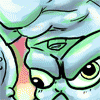
So I spent some time this last weekend reworking the head quite a bit. Added some ears, fixed a lot of the nose bridge that was bothering me, carved out some more space for the eyeballs to look angrier. Looks like I need to fix some shape issues on the left side. It's finally coming together into something I'm happier with. Still got a lot of refining to work out but overall shape is *getting there*.
I am open to criticism and tips!! This is my first time doing this and I'm learning as I go!
I am open to criticism and tips!! This is my first time doing this and I'm learning as I go!
Category Fursuiting / All
Species Unspecified / Any
Size 1000 x 644px
File Size 432.4 kB
Listed in Folders
Fuck criticism HERE'S SOME SWEET TIPS:
-Use large calipers to mirror proportions on either side of the head. (Making sure eyes are the same size, shape, nose-to-cheekbone distance is the same, etc)
-You can make contour stencils out of cardboard to use as a guide to mirroring complex curves such as the jaws and cheek bones, too.
-It might be helpful to use small red stickers on the foam head and draw small red dots on your reference material to see if the points line up the same and to your liking.
-Depending on the thickness of the outer felt material, you might be able to smooth out the geometry with soft clay, or add details like veins by affixing thick twine or thin strands of rope to your foam core. Taxidermists use pieces of rope on deer heads to give them convincing looking neck veins, but the pelt shows a bit more detail than felt might. This leads to the next tip:
-BEFORE COVERING THE HEAD, MAKE SMALL TEST PIECES! You may discover something super cool you didn't think of that you'd like to apply to the final head! Or you might find a catastrophic fuck-up before it destroys the final product! And making replicas of the eye sockets and other tricky areas will let you experiment with how to approach them and conquer any difficulty they might bring.
-Finally, don't let your husband eat all the glue.
-Use large calipers to mirror proportions on either side of the head. (Making sure eyes are the same size, shape, nose-to-cheekbone distance is the same, etc)
-You can make contour stencils out of cardboard to use as a guide to mirroring complex curves such as the jaws and cheek bones, too.
-It might be helpful to use small red stickers on the foam head and draw small red dots on your reference material to see if the points line up the same and to your liking.
-Depending on the thickness of the outer felt material, you might be able to smooth out the geometry with soft clay, or add details like veins by affixing thick twine or thin strands of rope to your foam core. Taxidermists use pieces of rope on deer heads to give them convincing looking neck veins, but the pelt shows a bit more detail than felt might. This leads to the next tip:
-BEFORE COVERING THE HEAD, MAKE SMALL TEST PIECES! You may discover something super cool you didn't think of that you'd like to apply to the final head! Or you might find a catastrophic fuck-up before it destroys the final product! And making replicas of the eye sockets and other tricky areas will let you experiment with how to approach them and conquer any difficulty they might bring.
-Finally, don't let your husband eat all the glue.

 FA+
FA+








Comments